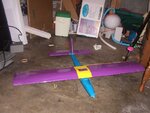You are using an out of date browser. It may not display this or other websites correctly.
You should upgrade or use an alternative browser.
You should upgrade or use an alternative browser.
Differrence between __ plane and 3d plane?
- Thread starter Chromenut
- Start date
opjose
Well-known member
3D Planes are specifically designed for "high alpha" manouvers.
That is, they are able to fly stunts where the wings are close to or fully stalled...
That is developing little to no lift.
- A 3D plane typically has HUGE control surfaces.
- It flies slow. Normally with a WIDE low pitch prop.
- It is NOT a good flyer at high speeds ( the surfaces tend to flutter ).
- The surfaces are designed to "live" in the prop wash, for control while the wings are stalled.
- The C.G. is as far back as possible, making rolls axial.
- The plane flies inverted and upright almost hands off.
- The plane tends to be overpowered ( to pull out of trouble )
That is, they are able to fly stunts where the wings are close to or fully stalled...
That is developing little to no lift.
- A 3D plane typically has HUGE control surfaces.
- It flies slow. Normally with a WIDE low pitch prop.
- It is NOT a good flyer at high speeds ( the surfaces tend to flutter ).
- The surfaces are designed to "live" in the prop wash, for control while the wings are stalled.
- The C.G. is as far back as possible, making rolls axial.
- The plane flies inverted and upright almost hands off.
- The plane tends to be overpowered ( to pull out of trouble )
Jimmy Newton
New member
You can also add to that list that they are built very light, and that being said; are very fragile.
opjose
Well-known member
Yes! I forgot that one...
I crushed the wingtips on my Giant U-Can-Do merely ( and somewhat lightly ) pushing the wings on the wing tubes.
I've since uncovered the tips and re-inforced the formers with ply so that has not happened again...
If I BREATH too hard on the skin of my Funtana s90 I'm liable to break the balsa skin!!!



I crushed the wingtips on my Giant U-Can-Do merely ( and somewhat lightly ) pushing the wings on the wing tubes.
I've since uncovered the tips and re-inforced the formers with ply so that has not happened again...
If I BREATH too hard on the skin of my Funtana s90 I'm liable to break the balsa skin!!!
Haole
Active member
You know, back when I was teen I had a twin electric model made by Kyosho. It was called the Duet. The fuselage utilized a really tough and light construction technique of molded foam under a heatwrapped skin--that being tougher than say Monokote or Oracover.
It was a durable little airplane. Is anybody using that type of film-over-foam core modeling in the ARF industry anymore? It'd be perfect for you aerobat nuts...
Carl
It was a durable little airplane. Is anybody using that type of film-over-foam core modeling in the ARF industry anymore? It'd be perfect for you aerobat nuts...
Carl
0xdeadbeef
New member
There are indeed quite a few 3D capable EPP foamies which are pretty durable. Two examples on the Swaps are the Hacker ZoomBi and the Multiplex AcroMaster.
This being said, I'd argue that there's no direct relationship between 3D capability and fragility. There are durable 3D planes and fragile non-3D planes.
This being said, I'd argue that there's no direct relationship between 3D capability and fragility. There are durable 3D planes and fragile non-3D planes.
opjose
Well-known member
While I like both of the planes you named, I wouldn't call either "durable".
Most 3D planes have very light structures. Even if re-inforced with CF, if wood or foam is used, it need be light, and usually fairly fragile as a result.
What other 3D planes would be considered "durable" or non-fragile?
Most 3D planes have very light structures. Even if re-inforced with CF, if wood or foam is used, it need be light, and usually fairly fragile as a result.
What other 3D planes would be considered "durable" or non-fragile?
rccardude04
New member
opjose said:While I like both of the planes you named, I wouldn't call either "durable".
Most 3D planes have very light structures. Even if re-inforced with CF, if wood or foam is used, it need be light, and usually fairly fragile as a result.
What other 3D planes would be considered "durable" or non-fragile?
ParkZone Typhoon/2
-Eric
Norton
New member
rccardude04 said:ParkZone Typhoon/2
I've seen those shatter into pieces. The motor mount and stock servo rods and horns are not that strong either. Let alone the servos that they come with!
Fun plane to fly but I don't they are considered tough.
2 Cents.......
P.S.
I remember a old Slope Soaring kit I had called a Super Cheetah, vacuum formed fuselage, hard wood main wing spar and leading edge with foam cores covered in balsa or thin card board.
We used to get 6 of these birds in the sky with 30 mph winds and just plow into each other all day. Worst damage was usually a wing got cut in half, 15 mins later you were in the air cutting the other guy's wing off.
They were very aerobatic planes, they were not 3D though.
If anybody has seen or has info on the Super Cheetah slope plane please let me know, I'd like to buy about 12 of them....
Just happened across this pic on the net. Pretty beat and ugly.
Weird also is they cut out the top of the nose and a hole at the tail. Not the way they were meant to be built!
TN..
Attachments
Last edited:


